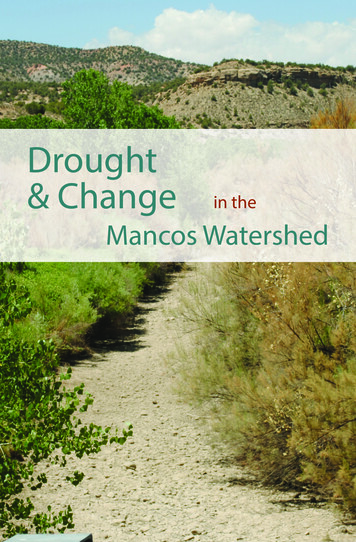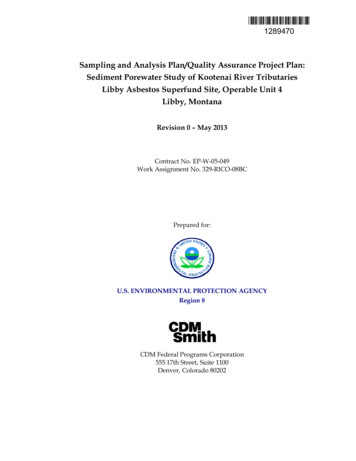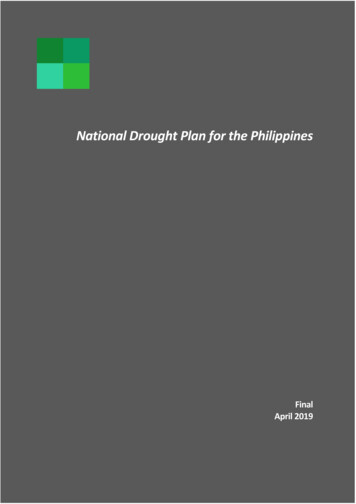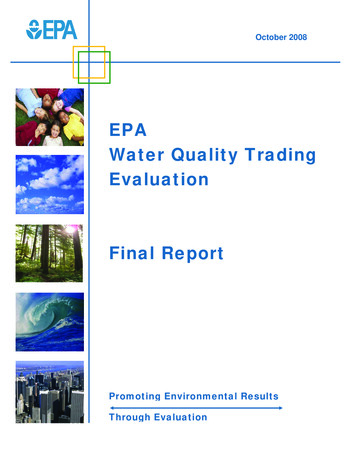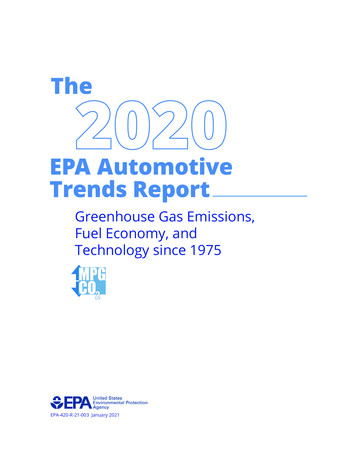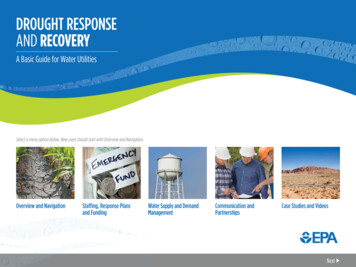
Transcription
DROUGHT RESPONSEAND RECOVERYA Basic Guide for Water UtilitiesSelect a menu option below. New users should start with Overview and Navigation.Overview and NavigationStaffing, Response Plansand FundingWater Supply and DemandManagementCommunication andPartnershipsCase Studies and VideosNext
DISCLAIMERStaffing, Response Plansand FundingWater Supply andDemand ManagementDemandThis Guide provides practical solutions to help drinking water utilities respond to and recoverfrom drought. This Guide is not intended to serve as regulatory guidance. Mention of tradenames, products or services does not convey official U.S. Environmental Protection Agency(EPA) approval, endorsement or recommendation for use.ACKNOWLEDGMENTSEPA wishes to thank the following utilities, organizations and individuals for theirparticipation in support of the project:Communicationand PartnershipsCase Studiesand VideosUtility Case StudiesFocus Group Members Tuolumne Utilities District (TUD),Sonora, California Mary Ann DickinsonAlliance for Water Efficiency (Corix) Spicewood Beach Water System,Spicewood, Texas Liz Gardener (retired)Denver Water City of Las Vegas, New Mexico Mike HoweTexas Section, AmericanWater Works Association City of Hogansville, Georgia City of Hays, Kansas City of Russell, Kansas City of Clinton, Oklahoma Steve LemoineSouth Grafton Water District,Massachusetts Lain LeoniakCity of Bozeman, Montana Melinda Moritz and David DimalineCity of Leon Valley, Texas Dale ReedWhite Bear Lake Township, MinnesotaEPA Office of Water MC 4608T EPA 810-B-16-001 March 2016Page 2Drought Response and Recovery: A Basic Guide for Water UtilitiesResourcesPreviousNext
OVERVIEW AND NAVIGATIONStaffing, Response Plansand FundingWater Supply andDemand ManagementManagementCommunicationand PartnershipsCase Studiesand VideosDROUGHT AND UTILITIESWHAT IS DROUGHT RESILIENCE?Many states have experienced prolongedperiods of abnormally dry or unusually hotweather that threaten the availability ofwater. This trend is projected to continue.Unlike other hazards, such as flooding andearthquakes, droughts develop graduallyover months or years — and it may take anaffected community or water utility just aslong, if not longer, to recover.For water utilities, drought resilience is theability to respond to immediate water supplythreats, withstand drought impacts andrecover quickly. Recovery includes consid ering long-term conditions and planning forpermanent solutions. All utilities should planto make their systems more resilient to theimpacts of drought. This Guide can help util ities respond to and recover from drought.Droughts can result in significant economic,social, environmental and water utilityoperational impacts, including:Drought-resilient utilities: Loss of water supply. Poor source water quality that mayaffect treatment and the ability tomeet drinking water standards. Stressed alternative and supplementarywater sources due to high demand byother drought-affected users. Increased demand from customers. Take action to protect human health andthe environment, while maintaining aminimum level of service for customersduring drought. Manage decreases in water supply,increases in water demand and changesin water quality.Although drought is usually a prolongedand slow-moving disaster, impacts cansometimes escalate suddenly and causewater supply disruptions in a matter ofweeks. That is why it is crucial for waterutilities to have an emergency responseplan for severe drought conditions, inaddition to longer-term strategies to copewith declining water supplies.Drought response includes taking immediateactions to maintain service to customers byincreasing supplies and reducing water use.This involves ensuring water for essentialservices such as medical care, fire protectionand general health and sanitation. For thepurposes of this Guide, drought responseactions are taken when a utility projectsthat their water supply may run out within180 days (6 months). Plan for future changes in weatherand climate patterns that can reducewater supply. Increased costs and reduced revenuesrelated to drought response.Page 3Drought Response and Recovery: A Basic Guide for Water UtilitiesResourcesPreviousNext
OVERVIEW AND NAVIGATION (Continued)Staffing, Response Plansand FundingWater Supply andDemand ManagementCommunicationand PartnershipsCase Studiesand VideosOnce drought conditions have lessened,utilities can begin drought recovery activitiesto restore service to previous or newly ad justed operating conditions. These activitiesmay include lifting water use restrictions,replenishing water supply sources andregaining financial stability. Utilities canalso explore incorporating new practices,projects and other mitigation measures intoday-to-day operations to be less vulnerableto and better prepared for the next drought.Drought response and recovery activitiesin this Guide cover:WHY DID EPA DEVELOP THE DROUGHTRESPONSE AND RECOVERY GUIDE? Communication and Partnerships.Establish and communicate key messagesto customers and stakeholders; developpartnerships.EPA developed this Guide to help drinkingwater utilities become more resilient todrought. The Guide presents real-worldexamples, best practices and lessonslearned in drought response and recovery. Staffing, Response Plans and Funding.Establish staffing and drought responseteams; develop drought response plans;consider funding and financing options. Water Supply and Demand Management.Estimate quantity of current watersupplies; develop ways to reduce wateruse; identify potential supplementalwater supplies.Utilities can use this Guide as a pre paredness tool if they are not currentlyexperiencing a drought. To increaseresilience to future droughts, utilitiesshould have an effective year-round WaterConservation Program and DroughtResponse Plan in place prior to a drought.Actions taken before a drought occurs,such as implementing a leak detectionand repair program, can increase availablesupplies and be more cost effective inthe long term.When working through the Guide, consider how the suggested actions may be adaptedto your utility’s priorities and available resources.Note that your state may have specific rules prohibiting or regulating some of theresponse actions presented in this Guide. Check with your state regulators or legalcounsel before putting any activities into practice.Page 4Drought Response and Recovery: A Basic Guide for Water UtilitiesResourcesPreviousNext
NAVIGATING THE GUIDEStaffing, Response Plansand FundingThe Guide is divided into four sections:Staffing, Response Plansand FundingWater Supply andDemand ManagementCommunicationand PartnershipsWater Supply andDemand ManagementCommunicationand PartnershipsCase Studies and VideosCase Studiesand VideosNavigate within and between sections usingthe clickable links on the far left and buttonson the navigation bar at the bottom of eachpage. Click NextorPrevious to movepage by page through the Guide.Note that all of the worksheets and linksembedded throughout the guide, as wellas additional resources related to droughtresponse and recovery, can be found byclicking on “Resources” at the bottom ofeach page.Navigate directly to the Case Studies andVideos section for more detail on the sixcase studies showcasing seven utilities thatsuccessfully responded to drought. Theirbest practices and real-world examples arereferenced throughout the Guide. The CaseStudies and Videos section will link youto the “Drought Response and RecoveryProject for Water Utilities: Case Studies Map.”This website features a geoplatform mapthat hosts short videos on each case study.In addition to the six case studies, videos onthe site also cover: System efficiency and new water sources Water demandSection features: Partnerships Call-out boxes highlighting bestpractices and real-world examples. Web links for learning more aboutspecific topics. Easy-to-use worksheets forspecific activities.Page 5Drought Response and Recovery: A Basic Guide for Water UtilitiesWORKSHEETSLook for this icon to open work sheets in Microsoft Word andExcel. You can fill in the worksheets andsave the information to your computer.Drought Response and Recovery Project forWater Utilities: Case Studies MapVIDEOSClicking on these video iconswill take you to the EPA’s DroughtResponse and Recovery Project for WaterUtilities: Case Studies Map website toview short videos.You must be connected to the Internetto be taken to the website. The websitefeatures all the videos referenced in thisDrought Guide. Click on the tabs at thetop of the Case Studies Map website tobrowse through the videos. The Over view tab explains how to use the map.ResourcesPreviousNext
STAFFING, RESPONSE PLANS AND FUNDINGStaffing, Response Plansand FundingWater Supply andDemand ManagementCommunicationand PartnershipsCase Studiesand VideosDROUGHT RESPONSE TEAMDrought response will involve internalcoordination with utility staff and externalcollaboration with other partners and stake holders. Designate a utility staff memberto lead and coordinate drought responseand planning activities. This person will puttogether a drought response team, whichwill include staff members who are involvedin the management of the water system. Formany smaller utilities, this may include theutility operator, city manager and city clerk.Other team members may include publicinformation specialists, conservation coor dinators, finance managers or legal counsel.This team will work with public and privatepartners and stakeholders throughout thedrought response.BEST PRACTICE: Establish a droughtresponse team with utility staff knowl edgeable in operations, communications,regulatory requirements, legal impactsand financial planning. Engage withoperators often. Tuolumne Utilities District, California.The water utility’s General Managerconvened their drought responseteam — including the District Engineer,Water Master (Operations Manager)and Public Relations Manager — toevaluate conditions, explore watermanagement and water supplyoptions, formulate recommendationsUTILITY STAFFINGDrought response activities may takepriority over other routine tasks and main tenance, and can increase staff workloads.Overtime expenses may increase, which canimpact the overall budget. During a drought,utility staff may need to: Respond to increased customer calls. Enforce water restrictions and respond tovariance requests. Communicate regularly with local mediaand the public.Consider hiring temporary staff orcontractors, reassigning staff or requestingresources from your Water/WastewaterAgency Response Network (WARN).to the Board and implement sug gested actions. Engaging this teamin weekly meetings provided a wayto jointly define the problem andensured staff members were coordi nating with each other and workingtogether effectively.Use Worksheet 1 to develop a list ofdrought response team members.Page 6Drought Response and Recovery: A Basic Guide for Water UtilitiesAfter the Drought: Write an after action report thatdescribes effective drought responseactions and areas that couldbe improved. Identify new standard operatingprocedures for future water shortagesand for routine operations. Keep your drought response teamactive by conducting droughtpreparedness activities.ResourcesPreviousNext
DROUGHT RESPONSE PLANSStaffing, Response Plansand FundingWater Supply andDemand ManagementCommunicationand PartnershipsCase Studiesand VideosUtilities should have a drought response planthat establishes drought stages, designatesreadily identifiable drought triggers, setsreduction goals, describes water use restric tions and outlines enforcement provisions.In many states, drought response plans arerequired. Develop or review your existing plan. Arethe conservation measures, demand re strictions and response actions adequateto respond to current drought condi tions? Is the plan flexible enough to giveyour utility and its governing body theability to declare a specific drought stageif unforeseen conditions occur? If not, youwill need to revise your plan. Check with local and state governmentofficials, as well as your wholesale waterproviders. Do they have an existingdrought response plan you can leverage,or do they have requirements for utilitydrought response plans?Use Worksheet 2 to help updateor develop your droughtresponse plan.The following key topics should be included in your drought response plan: Drought Stages and Triggers. Drought stages define actions required to respondduring various phases of drought severity. For example, Stage 1 could be to limit out door water use. Triggers are indicators that activate the drought stages. A trigger could bedefined as reservoir or groundwater well levels dropping a number of feet within a certaintime period or to a specific water level. Water Use Reduction Goals. Reduction goals can be expressed as percentagereductions from “normal” use or as reductions of a specific quantity in acre-feet ormillion gallons per day (MGD).– Have a clear understanding of what “normal” use is and update this definition atleast every 5 years.– Monitor water use frequently to see if reduction goals are being met and adjustthe plan as necessary. You may want to read meters of key customers or large waterusers more frequently to track their usage and ability to meet reduction goals duringthe drought. Water Use Restrictions. Restrictions are often designed to first reduce or eliminatenonessential uses such as outdoor watering, followed by more severe restrictions,as necessary.– Some utilities establish a per-person or per-household allocation (gallons permonth), allowing customers to determine how they want to reduce their use to meetthe allocation. Consider adding customer variance or appeal provisions for specialcircumstances.– Understand what your utility can achieve from certain water restrictions. If outdoorwater use has gone down over the last decade, the potential savings from outdoorwater use restrictions will need to be reduced from previous projections.– There is usually a time lag of a few months from when mandatory restrictionsare announced and when customers actually reduce their water use. Factor thisinto your plan. Enforcement Provisions. Drought restrictions can be enforced through educationalwarnings, code enforcement citations, police tickets, fines, fees, surcharges and waterservice disconnections.– Verify enforcement procedures with legal staff, as some states may have statutorylimits on allowed methods.Page 7Drought Response and Recovery: A Basic Guide for Water UtilitiesResourcesPreviousNext
BEST PRACTICE: Establish a droughtresponse plan that includes trigger levelsStaffing, Response Plansand Fundingand water use reduction measures. De velop a clear but flexible plan, includingspecific reduction goals and restrictionsto address current and anticipated con ditions. Do not wait for an emergencyWater Supply andDemand Managementto occur before you develop a plan. City of Russell, Kansas. During 8of the last 12 years, Russell declaredStage 3 or 4 of drought management.Communicationand PartnershipsHaving a drought response plan thatclearly defines drought triggers andresponse actions for four droughtstages helps their customers beprepared and enables them to takeCase Studiesand VideosPage 8After the Drought: Revise your drought response planbased on lessons learned, consideringthe following:– Did the drought stages, triggersand demand reduction measuresachieve the anticipated results?– Were the demand reductionmeasures too prescriptive, or didthey not provide enough directionto customers? Incorporate drought resilience plansor projects into multiyear capitalimprovement plans and budgets. Conduct a debrief with utility staffand partners shortly after the droughtto discuss the effectiveness of andimprovements to response activities.actions quickly when drought occurs.Drought Response and Recovery: A Basic Guide for Water UtilitiesResourcesPreviousNext
TRAINING AND EXERCISING ONDROUGHT RESPONSEStaffing, Response Plansand FundingWater Supply andDemand ManagementCommunicationand PartnershipsBEST PRACTICE: “Practice the drought”with key staff in the utility or with exter nal stakeholders to uncover the opera Train all staff on drought impacts andresponse procedures by holding table top exercises or walking through droughtresponse plans and procedures. Provide up to-date information to office and customerservice staff as well as operators. Invite rep resentatives of the following entities to theexercises: nearby utilities, large water users,fire departments, emergency operationscoordinators and other partners that will havea significant role in the drought response.Local emergency managers can help utilitiesdevelop and facilitate tabletop exercises.tional difficulties and details associatedwith drought contingency strategiesbefore the next crisis begins. (Corix)1 Spicewood Beach WaterSystem, Texas. The utility’s droughtresponse plan included trucking waterin as a back-up water supply. Duringthe 2011 – 2012 drought, however, theyhad difficulty finding potable wa ter-certified trucks and hauling routeswith roads rated for the trucks’ filledAfter the Drought:Schedule an annual tabletop exerciseto practice different drought scenarios.Potential topics include: Requirements for hauling potablewater, including availability of tankertrucks, hauling routes, truck disinfec tion, maintenance and operationalprocedures for introducing water intothe system. Identifying additional water sourcesor operational changes to expandwater supplies. Procedures for communicating withcustomers and large water users.weight. They learned the importanceof having a “Plan B,” and the utilityplans to conduct regular emergen Case Studiesand Videoscy preparedness exercises with keypersonnel. Tuolumne Utilities District, California.The District routinely participates infocused emergency response tabletopexercises with other local, county andstate agencies. Each exercise focusesFOR MORE INFORMATION ONEXERCISES, VISIT: U.S. EPA’s Tabletop Exercise Tool forWater Systems: Emergency Preparedness,Response, and Climate Resiliency U.S. EPA’s Workshop Planner for ClimateChange and Extreme Events Adaptationon a different scenario so participantscan develop solutions for specificproblems.1Page 9Drought Response and Recovery: A Basic Guide for Water UtilitiesCorix is an investor-owned water company that purchased theSpicewood Beach Water System from the Lower Colorado RiverAuthority in 2014.ResourcesPreviousNext
FUNDING AND FINANCINGCONSIDERATIONSStaffing, Response Plansand FundingWater Supply andDemand ManagementCommunicationand PartnershipsUtility budgets can be significantly impactedduring drought due to declining revenuesfrom reduced water use and increasingcosts of operations and drought responseactivities. These financial impacts can con tinue for an extended period of time, evenafter the drought has ended.At the start of your drought response,estimate these losses and increasedexpenses for budget planning, so youcan maintain critical services.Consider the following funding sources to help recover revenue and offset losses: Conservation rate structure. Tiered or base-excess use rates that are higher for greatervolumes of water used encourage water conservation. Engage with large water usersand community representatives before changing a rate structure to prepare customersfor new rates. You may want to consider a rate structure design that recovers most ofyour utility’s fixed costs in the base rate, while still ensuring that the rates are affordablefor all customers. Emergency pricing or surcharge. This includes usage rates that can be applied asconsumption increases, or rates that can be increased as the drought worsens. Workwith your state to see if this type of charge is possible and what the approval processwould be. In some states, these approvals can take months. Dedicated conservation or drought response fund. This includes a “set-aside” fundfor conservation efforts or as a reserve fund for revenue stability during drought. Dedicated sales tax. A portion of sales tax revenue could be applied to drought responseand resilience activities. Work with your state to see if this is possible for your city.Use Worksheet 3 to put togetheran overall work plan and timelinefor drought response activities.Case Studiesand VideosBEST PRACTICE: Partner with local andregional entities to leverage availablestate and federal funds to reduce the im pacts of rate increases on your customers. (Corix) Spicewood Beach WaterSystem, Texas. The utility worked with State funding. This category includes available funds for emergency response, waterplanning, conservation, economic development or innovative technology. Check withyour local, county or state officials to see if these funds are available and to help you withaccessing them. Coordinate with officials to see if the governor can declare an emergen cy to access emergency response funds or request resources or other assistance. Federal funding. This includes grant or loan programs from federal agencies, includingEPA’s State Revolving Fund, Federal Emergency Management Agency’s (FEMA’s) HazardMitigation or Public Assistance Programs, and the U.S. Department of Agriculture’s RuralDevelopment Loan & Grant Program. Check agency websites or with local officials foreligibility requirements and applications. Other assistance. Mutual aid programs (such as WARN) or water sector associations, such asthe National Rural Water Association, could provide in-kind services to help with:their county judge and state officials– Repairs, such as to line breaks due to shifting dry ground.to fund water supply projects. The– Resource loans for personnel (such as extra operators) or equipment (such asgenerators, pumps, water hauling trucks or portable treatment plants).county was awarded a 350,000grant by the Texas Department ofAgriculture, which made disaster reliefUtilities may be able to find local training opportunities on general financialmanagement and rate setting to learn how to build reserves.funds available for drought projects.Page 10Drought Response and Recovery: A Basic Guide for Water UtilitiesResourcesPreviousNext
Staffing, Response Plansand FundingBEST PRACTICE: Implement a rateBEST PRACTICE: Supplement revenuestructure that will stabilize revenues tofrom water rates with other sourcescover your fixed costs, but has conserva of funding.tion pricing (tiered and seasonal rates)to send a pricing signal to help reducedemand. Explore the option of adoptingspecial drought rates.Water Supply andDemand ManagementCommunicationand Partnerships (Corix) Spicewood Beach Waterauthorizing the city to collect a halfcent sales tax dedicated to funding aproposed groundwater project thatwould supplement their surface watertiered rate approved by state regula supplies. The sales tax will increase intors to encourage water conservation.4 years by an additional half cent. Alliance for Water Efficiency’s“Financing Sustainable Water” Exit U.S. EPA’s Federal Funding for Utilities —Water/Wastewater — in National Disasters(Fed FUNDS) FEMA Climate Resilient MitigationActivities ExitThe base rate covered approximately80 percent of the utility’s fixed costs,the rest; this provided revenue stabil ity during the drought, when waterdemand was reduced. City of Hogansville, Georgia. The citypromotes conservation year roundthrough a tiered rate structure withhigher water rates assessed for highervolumes of use. This rate structurealso provided revenue stability forthe city as customers’ water demanddropped during the drought.Page 11residents passed a referendumSystem, Texas. The utility adopted awith the demand charges coveringCase Studiesand Videos City of Clinton, Oklahoma. ClintonFOR MORE DROUGHT FINANCINGINFORMATION, VISIT:Drought Response and Recovery: A Basic Guide for Water UtilitiesAfter the Drought: Revenue recovery can be difficult, aswater use may never come back topre-drought levels. Working with local,county and state officials may helpsecure funding and technical assistanceif you implement large projects tobuild longer-term drought resilience,such as new groundwater wells andinterconnections. Continue to engage with state officials toget approval for a surcharge (if required),so that you will be able to activateit if needed during future droughts.ResourcesPreviousNext
WATER SUPPLY AND DEMAND MANAGEMENTStaffing, Response Plansand FundingClick on the video icon to go to the Drought Response and Recovery Project for Water Utilities: Case Studies Map to watch videos about utilitywater supply and demand actions.During a drought, management actionsfor water supply and water demand shouldoccur at the same time. Key actions includedetermining:Water Supply andDemand Management How much supply is available. How to improve system efficiency. Local or regional water supply agencies,conservancy districts, groundwatermanagement districts or river authorities. U.S. Geological Survey or reservoir own ers and operators such as the U.S. ArmyCorps of Engineers or U.S. Bureau ofReclamation. How to reduce customer demand.Communicationand PartnershipsCase Studiesand Videos How to identify additional water supplies,if needed.DETERMINE WATER SUPPLY AVAILABILITYUnderstanding the conditions and charac teristics of your water supplies is important,but it is critical during drought. During ex treme drought, your utility should increasemonitoring and look for changes every day.Start regularly monitoring water suppliesand production capabilities and developsupply projections. Inexpensive wellsounding equipment to monitor groundwa ter levels may be an option for systems withgroundwater sources. Monitoring weatherforecasts can help you understand how longyour water supply will last if the droughtpersists or worsens.The following local, regional, state and fed eral resources may track water supply con ditions and drought forecasts in your area: Neighboring water and power utilities. State water agencies.Page 12may require adjusting the treatment pro cess to meet drinking water regulations.You should also increase sampling indistribution and storage to check theage of finished water.BEST PRACTICE: Increase frequencyof water supply and well productionFor many utilities, accessing available waterbecomes a challenge. In this case, considerthe following measures:monitoring to detect changes in supplyavailability and forecast availability, ifdrought conditions persist or worsen. Constructing floating intake structuresin rivers or reservoirs. Tuolumne Utilities District, California. Installing temporary low-head dams toincrease water levels.Throughout the fall and spring, the Lowering a groundwater well pump.and snow surveys from national and Rehabilitating or deepening an existingwell.state sources, such as the National Adjusting well cycle time to allow forwater level recovery.istration, National Weather ServiceCheck with regulatory authorities to findout if you need a variance or permit toimplement any of these measures until thedrought emergency is over.Resources, to estimate available waterutility uses precipitation forecastsOceanic and Atmospheric Admin and California Department of Watersupply before peak summer use.Be sure to increase sampling of sourcewater during drought to continuouslymonitor water quality. Higher temperatures,low flows, changes in the watershed anddropping surface and groundwater levelscan change water chemistry. These changesDrought Response and Recovery: A Basic Guide for Water UtilitiesUse Worksheet 4 to estimateavailable water supply at yourutility. The worksheet can be usedfor surface water and groundwater.ResourcesPreviousNext
After the Drought:Staffing, Response Plansand FundingWater Supply andDemand Management Continue or increase monitoringactivities to maintain a full awarenessof the condition of your water supply. Develop a plan to implement projectsthat address your long-term needs soyour utility is more resilient to futuredroughts.FOR MORE ON DROUGHT FORECASTING:Communicationand Partnerships U.S. Drought Monitor Exit U.S. Seasonal Drought Outlook Exit Snow Telemetry (SNOTEL) Snow Survey& Water Supply Forecasting ExitCase Studiesand VideosPage 13Drought Response and Recovery: A Basic Guide for Water UtilitiesResourcesPreviousNext
IMPROVE SYSTEM EFFICIENCYStaffing, Response Plansand FundingWater Supply andDemand ManagementImplement measures to conserve waterwithin your treatment and distribution systemwithout affecting drinking water qualityor other operational or regulatory require ments. During a drought, it is important tomake improvements to your system firstto set the example for your customers.Measures could include: Exploring beneficial uses for flushed water,such as irrigation, construction, fire-fightingstorage or other non-drinking water uses. Recirculating backwash water to the headof your treatment plant. Aggressively finding and repairing leaks;consider including the following consider ations and actions in your leak detectionand repair program: Reducing pressure throughout all or part ofthe distribution system, while maintainingnecessary pressure for “high priority”users such as hospitals and firefighters.Communicationand PartnershipsCase Studiesand Videos Limiting main flushing as much aspossible, while still meeting all regulatoryrequirements.– Installing automated meter readingsystems that can provide real-timewater leak information.– Messaging, such as “Find It and FixIt,” to immediately repair a leak on thecustomer side of the meter.– Establishing a leak and minorplumbing repair program for lowincome households.– Encouraging self-policing by residentsto alert the utility of system leaks.BEST PRACTICE: Look for ways to manage your existing supplies through demandmanagement, or modify system operations to increase supplies.ideas to reduce ini
Drought Response and Recovery: A Basic Guide for Water Utilities Staing, Response Plans and Funding . Water Supply and Demand Management . Communication and Partnerships . Case Studies and Videos . OVERVIEW AND NAVIGATION (Continued) Page 4 . Once drought conditions have lessened, utilities can begin drought recovery activities

